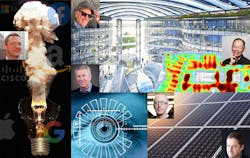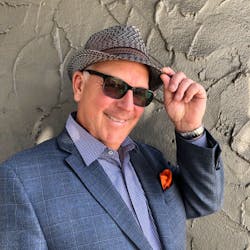Much of the past event coverage has focused on presentations during the core Strategies in Light conference, but we cannot overlook the in-depth learning opportunities of the pre-conference workshops. We spoke recently with Clifton Stanley Lemon about the upcoming workshop he will lead on Tuesday, Feb. 11, 2020, called “What to Build and When to Build It? A Scenario Planning and Decision Support Workshop for Lighting & Technology Companies.” According to Lemon, in keeping with a return to the Strategies in Light roots, this workshop is all about — wait for it — strategies in the lighting industry. It is designed for product managers, engineers, designers, sales and marketing professionals, specifiers, technical advisors, and C-level company officers, consultants, and investors in lighting and electronics manufacturing companies who need tactical decision support tools.
What is unusual about the workshop is what Lemon called a “futurist approach” during a recent conversation, in which he observed that as it seems to be increasingly technology-driven, the solid-state lighting (SSL) industry “constantly expects big shakeups, but when they happen, they don't happen in the way we forecast and we don’t know what to do with them.” He works with companies using a technique called scenario planning (invented by the US Department of Defense during the Cold War to manage the threat of nuclear destruction) as a decision support tool. "Lighting companies too often become overwhelmed or distracted by technology and fall into a reactive stance to market swings and 'disruptions.' Scenario planning offers a much better alternative," said Lemon.
The team handling this workshop is a cast of experts from all SSL areas, including Lemon, who is CEO of Clifton Lemon Associates; Eoin Billings, director of Billings Jackson; Jerry Mix, president of Finelite; Paul Pickard, CTO at Ecosense; David Wilts, founder and CEO of Digital Masterplanning; and Scott Yu, chief creative officer and owner of Vode Lighting. Whether you’re looking to reformulate your product development strategy or pre-plan for multiple business opportunities, it sounds like this workshop would be an excellent place to start.
“Formulating (and constantly refining) multiple
plausible futures is ultimately much
more useful than clinging to a single vision
based on the flavor-of-the-year technology or prediction.”
LEDs Magazine: In our recent chat, you mentioned wanting to shake up the format of past workshops and offer something that participants could use in forward planning. How does this class/seminar format differ from past workshops you’ve seen or run?
Clifton Stanley Lemon: Most public learning situations follow a passive master-student lecture format, which is fine as it only requires the audience’s attention and the speaker’s ability to hold it. I like to explore more active ways of learning, and a participatory workshop format is an effective way to do that. With this particular workshop, we see an evolution from the topics of my previous SIL workshops — the design of cities, luminaires, and buildings — to actively designing your future. My operating idea here is a quote from Buckminster Fuller: “We are called to be the architects of the future rather than its victims.” I’ve been delighted with the results of the design charrette approach in the previous workshops, as many participants had never done anything quite like that before and were able to collectively come up with really creative and useful ideas in a very short time and have a lot of fun along the way. This workshop is similar in some ways but in others raises the stakes considerably; we’re looking at “designing” a company with strategy, critical thinking, and a technique with a very well defined methodology — scenario planning.
LEDs: The participant targets for this class seem broadly distributed. How do you see a range of folks, from product developers to C-level executives to investors, utilizing the knowledge offered in this workshop?
Lemon: Beyond the specific learning objectives, per our conversation I think the most important value anyone can get from the workshop is to counter the pervasive “techno-chaos” — the feeling of being constantly overwhelmed by technology and the future. With the advent of a massive deluge of readily available information and choices, this feeling is unavoidable, and has been ruinously exploited by governments (therefore Trump); Big Tech (Facebook, Google, Apple, etc.); hackers (ransomware, identity theft, etc.); and communications monopolies (AT&T, Comcast, etc.).
If you’re running a small or mid-sized manufacturing business, which are the most common in the lighting industry, it’s far too easy to succumb to choice paralysis or make investment or deployment decisions that are far riskier than you would want. This workshop will encourage people to slow down, stop overthinking, over-metricizing, and getting lost in the weeds. Looking at history is particularly refreshing and helpful. And formulating several plausible futures is ultimately much more useful than clinging to a single vision based on the flavor-of-the-year technology.
Related: Experts debate key issues that lighting professionals face relative to LEDs and SSL
LEDs: In our previous conversation, you called the approach to this class “futurist” and said the scenario planning concept that frames this workshop “isn’t about right or wrong but about multiple plausible futures.” How do you and your colleagues plan to balance the idea of futurism or forward-thinking with immediately usable planning and problem-solving strategies?
Lemon: That’s a great question! I’m now acquiescing to being called a “futurist” for years, and going with the flow. It’s hard and counterintuitive and complicated to keep multiple plausible futures in our minds, but not impossible once you get used to it. The prerequisites for effective future building include lots of preparation, homework, research, constantly being aware of trends and trajectories in everything that impacts your business: culture, politics, economics, technology, regulatory constraints, education, social patterns. Fortunately, much of this is made easier with our unprecedented access to information today.
Also, I need to explain here the relationships between predictions, forecasting, and scenarios; it’s about gradation and scale. We pay attention to single oracular prophesies like those uttered by religious leaders or Silicon Valley bigshots (they have a lot in common) because they're salient and dramatic, but they don't depend much on probabilities or shades of meaning, as in: "The future is cloud computing, so there." Unfortunately, they’re usually wrong, and the really strange thing is that it doesn’t seem to matter; we keep listening to them anyway. And with the advent of crowdsourcing — global brain, wisdom of the crowd, whatever you want to call it — we’ve discovered that it’s possible to make increasingly accurate, hence more useful, predictions about certain kind of granular trends.
This is all very well detailed and proven out in the book Superforecasting by Philip E. Tetlock and Dan Gardner. What’s different about forecasting is that the idea of probabilities is introduced, like in weather forecasting. This isn’t intuitive or easy to explain, but it is useful.
Scenarios take a broad spectra of predictions and forecasts about a wide range of factors impacting any particular decision, like “should we put sensors into all our fixtures?” and use them to construct salient narratives that drive strategic planning. A very important part of this is that once the narratives are built, they can and should be revised often, and company strategy can and should change direction based on new evidence, which emerges constantly.
Join us at Strategies in Light, at the San Diego Convention Center, on Feb. 11, 2020 to participate in this hands-on learning opportunity. Experience the full event from Feb. 11‒13, 2020, including the Sapphire Awards presentation aboard the USS Midway on Feb. 12.






